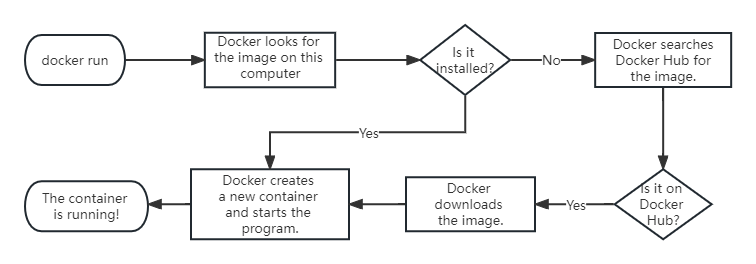Understanding Docker: Introduction
In this post, we will introduce the basic concepts of Docker. You’ll learn what docker is, why and when to use it.
What is Docker
Docker is an open source project for building, shipping, and running programs. It is a command line program, a background process, and a set of remote services that take a logistical approach to solving common software problems and simplifying your experience installing, running, publishing, and removing software. It accomplishes this by using an operating system technology called containers.
Running the hello-world in a container
Before running the hello-world program in a container, you need install Docker on your computer. You can download and install a Docker Desktop from https://docs.docker.com/install/. If you want to use docker on a Linux cloud server, you can download and install a Docker Engine from https://docs.docker.com/engine/install/.
After Docker is up and running on your computer, you can enter the following command to run the hello-world program provided by Docker in a container:
docker run hello-world |
After execute the above command you can see the output of the hello-world program
Hello from Docker! |
After print the above text, the program exits, and container is marked as stopped. The running state of a container is directly tied to the state of a single running program inside the container. If a program is running, the container is running. If the program is stopped, the container is stopped. Restarting a container will run the program again.
In the second time to run a container, you can use docker start <container> to run an existing container directly instead of create a new similar container from its image again.
The process of the docker run command execution is:

The hello-world is called the image or repository name. You can think of the image name as the name of the program you want to install or run. The image is a collection of files and metadata. The metadata includes the specific program to execute and other relevant configuration details.
Docker Hub is a public registry provide by Docker Inc. It is a repository service and it is a cloud-based service where people push their Docker Container Images and also pull the Docker Container Images from the Docker Hub.
Container
Historically, UNIX-style operating systems have used the term jail to describe a modified runtime environment that limits the scope of resources that a jailed program can access. Jail features go back to 1979 and have been in evolution ever since. In 2005, with the release of Sun’s Solaris 10 and Solaris Containers, container has become the preferred term for such a runtime environment. The goal has expanded from limiting filesystem scope to isolating a process from all resources except where explicitly allowed.
Using containers has been a best practice for a long time. But manually building containers can be challenging and easy to do incorrectly. Docker uses existing container engines to provide consistent containers built according to best practices. This puts stronger security within reach for everyone.
Containers vs Virtual machines
Virtual machines
- Every virtual machine has a whole operating system
- Take a long time (often minutes) to create.
- Require significant resource overhead.
Container
- All Docker containers share an operating system.
- Docker containers don’t use any hardware virtualization. Programs running inside Docker containers interface directly with the host’s Linux kernel.
- Many programs can run in isolation without running redundant operating systems or suffering the delay of full boot sequences.
Running software in containers for isolation
Each container is running as a child process of the Docker engine, wrapped with a container, and the delegate process is running in its own memory subspace of the user space. Programs running inside a container can access only their own memory and resources as scoped by the container.
Shipping containers
Docker use images to shipping containers. A Docker image is a bundled snapshot of all the files that should be available to a program running inside a container. You can create as many containers from an image as you want. Images are the shippable units in the Docker ecosystem.
Docker provides a set of infrastructure components that simplify distributing Docker images. These components are registries and indexes. You can use publicly available infrastructure provided by Docker Inc., other hosting companies, or your own registries and indexes. You can store and search images from a registry.
Why Use Docker
Docker makes it easy and simple to use the container and isolation features provided by operating systems.
Why use the container and isolation features
- Dependency conflict.
- Portability between operating systems. Docker runs natively on Linux and comes with a single virtual machine for macOS and Windows environments. You can run the same software on any system.
- Protecting your computer. Docker prevents malicious program attacks through operating system resource access control.
- Application removal. All program execution files and program-produced files are in a container. You can remove all of these files easily.
When to use Docker
Docker can run almost anywhere for any application. But currently Docker can run only applications that can run on a Linux operating system, or Windows applications on Windows Server. If you want to run a macOS or Windows native application on your desktop, you can’t yet do so with Docker.
References
[1] Jeffrey, Nickoloff and Stephen, Kuenzli. Docker in Action. 2nd ed., Manning Publications, 2019.